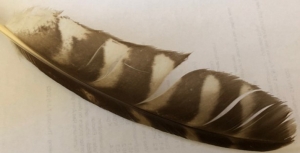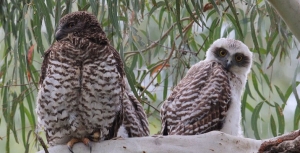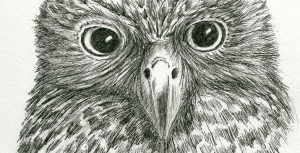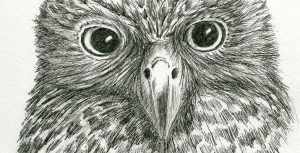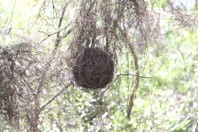Displaying items by tag: Powerful Owl
Powerful Owl feather identification guide
Dr Holly Parsons and the Powerful Owl team from Birdlife Australia, with financial assistance from a Ku-ring-gai environmental levy grant, have written a fascinating Powerful Owl feather identification guide.
Here is a taste of the information in the guide.
Identifying a species by a single feather can be very challenging. This guide has been designed by the Powerful Owl Project to help you determine if you have found a Powerful Owl feather. We have also included images of other species whose feathers look similar. The guide focuses mostly on wing and tail feathers as they are most often found but we have provided examples of other feathers where available
A feather found on the ground can tell us a lot of useful information. It can pinpoint locations that are important to birds, inform us of movement patterns and can even be used for genetic testing. A simple feather can help direct important conservation efforts!
Feather anatomy
Feathers are remarkably light and strong. They are composed of keratin, which is the same protein that makes up our hair and nails, as well as the scales of reptiles. A feather consists of a central hollow shaft, called a rachis, rather like a tree trunk. The feather shaft has two vanes, flattened parts of the feather attached on either side of the rachis. The vanes are formed by barbs that branch from the rachis like the branches of a tree. These barbs bear barbules that radiate, like the smaller branches of a tree. Tiny hooks on the barbules connect the barbs together to form the flat plane of the feather vane.
When birds preen, they run the length of the feather through their bills, which engages the barbules and shapes the barbs into a vane, making the feather work as one continuous unit. This helps birds to fly, stay warm and repel water.
Collecting feathers (or rather, not)
While it is very tempting to collect feathers that you find, every state and territory in Australia actually has rules and regulations around the collection of bird feathers. In NSW it is illegal to retain a bird specimen or parts of it (including feathers) without the appropriate permission from the NSW National Parks and Wildlife Service.
There is also a very small, but real risk of infection from a number of diseases when coming into contact with wild birds, their secretions, droppings and feathers. So rather than collecting feathers (or other bird parts), simply admire it, take a photo, and leave it in place (unless you are part of a project with the appropriate scientific licence). If you do touch feathers, be sure to wash and sanitise your hands afterwards.
If you find a Powerful Owl feather, please email This email address is being protected from spambots. You need JavaScript enabled to view it. and include a photo and other relevant information such as the date and location.
Powerful Owl Project reaches a landmark
It is ten years since the Powerful Owl Project was initiated under the auspices of Birdlife Australia. This highly successful project aims to involve the general public in discovering information about the Powerful Owl population, their location and behaviour and carry out research into their health and habitat needs.
The intrepid citizen scientists have far exceeded the original expectation of finding 50 territories in Greater Sydney and surrounds; the total now is over 250. Their observations have contributed enormously to the understanding of the ecology of the Powerful Owl in the urban environment.
Here are some extracts from the newsletter that documents the experience of the last 10 years or so.
Breeding success
It’s been a good breeding season for our urban owls, with 95 successful breeding sites and 157 chicks fledged, up from 121 chicks fledged last year. It’s been a good year for double chick clutches, with 65.3% of clutches having two chicks, up from 39.5% last year. The table below gives an overview of the breeding season stats for the past few years.

Research into nesting hollows
We know Powerful Owls need large tree hollows to breed, but we don’t know much about the environmental conditions inside the hollows where successful breeding takes place.
In March 2021, data loggers were installed in 11 known Powerful Owl nesting hollows across the Sydney Basin, funded through Cumberland Bird Observers Club. The data loggers measured the temperature and humidity levels in the hollows during the breeding season and were retrieved again in November. A huge thank you to Kai Wild, arborist and environmental campaigner, who installed and retrieved the loggers.
Powerful Owls successfully use both dead trees and live trees for nesting. We had hoped to install the data loggers in a representative sample of each, but the dead trees proved too dangerous to climb.
We are rapidly losing our old, hollow-bearing trees through land clearing, bushfires, drought, safety concerns and natural attrition. A hollow suitable for a Powerful Owl to breed in takes 150 to 500 years to form. At current rates of loss, scientists have estimated that in 95 years there will be no suitable tree hollows left in the urban space that can accommodate the breeding of Powerful Owls.
The results of the analysis will be available in January 2022. They’ll help inform land management decisions around the retention of hollow bearing trees and help guide attempts to design artificial nesting structures for Powerful Owl. To date, all attempts have been met with owly disdain, other than on one occasion where the owls successfully fledged a chick from a nest box but have not returned to it in subsequent seasons.
Mortality
Sadly there were 82 death and injury events recorded in 2021. 85% of these birds were either killed outright or died in care due to their injuries. For all reports we received we collated all the information we could on where the bird was found, what the physical signs were and, where possible, bodies were collected and necropsied.
These numbers are, sadly, more than double that of 2020, largely due to a doubling in reported cases of motor vehicle accidents and an increase in death or injury from animal attack or from unknown cause. Of course, as people become aware of the ability to report incidents then of course reporting to us increases so it is difficult to determine just yet whether these events are increasing, or people are simply more aware of how to report them.
What we do know though is that motor vehicle accidents continue to be the largest single cause of death and injury in our urban owls with 39% of reported injuries/deaths in 2021 and 50.4% of injuries/deaths in our records since 2012.
What to do if you find an injured or dead owl
If you find an injured Powerful Owl do not attempt to rescue the owl yourself, for the safety of both yourself and the owl. The rescue of raptors requires specialist training and handling.
Assess the environment for any potential danger to yourself. Check if there are any immediate threats to the owl. Take note of your location (GPS coordinates or address). Then call a specialist wildlife rescue organisation and they will talk to you, assess the situation, and decide what action needs to be taken.
If you’re in the Sydney Metropolitan Area, please call either of the following (both available 24 h day, every day of the year):
- Sydney Wildlife Rescue on 9413 4300
- WIRES on 1300 094 737
If you find a dead Powerful Owl, please let someone know, as knowing how many Powerful Owls are dying, and where and why they are dying, is important for our understanding of how to support the survival of the species.
Rodenticides
The use of rodent poisons is a major concern for the survival of all raptor species. Of particular concern is what are called second-generation anticoagulant rodenticides (SGAR). These are rat poisons with the active constituents of brodifacoum. Studies of dead Powerful Owls has shown that we can add Powerful Owls to the more than 40 Australian animals and bird species that are poisoned by these products.
There is more work to come, but early results from our research are alarming and is why we will be pushing forward with this research and actively campaigning for the removal of these second-generation rat poisons from public sale. From our first batch of testing we have found:
- 37 of the 38 samples showed an anticoagulant rodenticide was present.
- The most common rodenticide present was brodifacoum. Brodifacoum is a SGAR, the most persistent anticoagulant rodenticide registered for use in Australia, and is the most common one used in rat poisons available on hardware and supermarket shelves.
- Nearly 60% of Powerful Owls tested had levels high enough to cause impairment. This likely puts these birds at greater risk of other threats such as being hit by vehicles – the leading cause of death we are seeing in these Sydney birds.
- An additional 10.5% had AR levels high enough to kill the bird outright.
How you can help
As the largest hardware retailer, Bunnings can be leaders in the market by removing a huge source of poison from their shelves and instead providing consumers with alternatives that are just as effective.
Sign our petition, but also use our Bunnings finder to (politely and respectfully) call your local Bunnings store and let them know you are concerned about this issue. We even have a script for you to use.
Powerful Owl Coalition
STEP is a member of the Powerful Owl Coalition, a group of northern Sydney environment groups that aims to promote improvement in habitat for Powerful Owls. We have been working with Dr Beth Mott the head of the project for the past five years. Sadly she has moved to another job. We greatly appreciated her extensive knowledge and assistance with our work.
Powerful Owl Coalition
STEP is one of a group of environmental organisations that has got together to write a position paper on the habitat needs of the Powerful Owl. This iconic bird is a keystone species for maintaining ecological balance in our bushland.
We now will be recruiting other groups to help disseminate the report to all areas where Powerful Owls live.
Powerful Owl Coalition
Protecting Powerful Owls
Coalition membership
The Powerful Owl Coalition is a group of concerned community environmental groups working in collaboration with the Powerful Owl Project of Birdlife Australia.
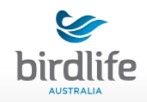

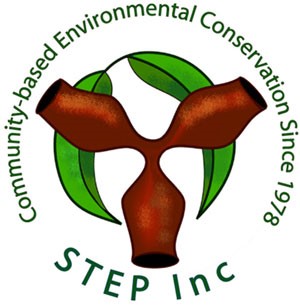

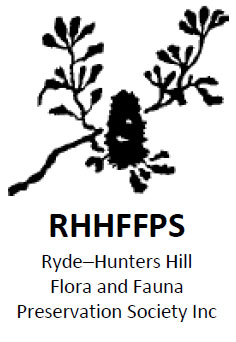
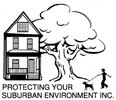


This page is hosted by STEP on behalf of the Powerful Owl Coalition
Powerful Owl Project Finishes but New Coalition Formed
The Powerful Owl is a keystone species of bushland in eastern Australia. The survival of the current population of this top predator is a key factor supporting the maintenance of a balance of fauna species and is an indicator of health in our ecosystems.
The Powerful Owl Project commenced in 2011 and is co-managed by BirdLife Australia’s Birds in Backyards program and the Threatened Bird Network. We reported on the activities of the Project in STEP Matters 169. Sadly, however, unless a new source of funds can be found the funding for this Project will run out on 30 June.
The Project has generated a lot of awareness of the existence of these iconic birds in Sydney’s bushland. One owl even has a Facebook page, Mikey the Owlet who lives in Byles Creek Valley Beecroft.
The objectives of the Project are:
- to engage the community to collect data to inform the conservation status of Powerful Owls in the Sydney Basin
- to identify site-specific management recommendations for all stakeholders and land managers with breeding pairs of Powerful Owls
- to inform, coordinate and support management amongst stakeholders and between land managers for conservation of Powerful Owls and other species
A major report was published in December 2014 but research has continued until now.
A conference was held on 8 June to provide a wrap up of the current data about urban Powerful Owls in the Greater Sydney Basin.
 Powerful Owl Coalition
Powerful Owl Coalition
We all want to continue to give Powerful Owls a high profile. STEP and four other conservation groups from northern Sydney have got together to form a coalition with the following aims:
- to be proactive, not reactive, about their protection
- to educate and inform residents and organisations about their ecological importance
- to provide advice about habitat provision and maintenance
We have produced an information flier that will be distributed throughout local communities.
A detailed paper is being written to provide the latest understanding of the habitat conditions needed for the Powerful Owl’s survival, for breeding and foraging. Information will be tailored for all groups whose activities impact of Powerful Owls such as arborists and planners.
All groups concerned with bushland conservation are invited to join the Powerful Owl Coalition to help spread the word.
More information
Protecting Powerful Owls
More information
Birdlife Australia's Powerful Owl Project
Download a flier and give it to your friends and neighbours to read
Download our position paper paper which is designed to educate and encourage all levels of government, professionals, groups, communities and individuals to protect and increase the number of Powerful Owls in urban areas
Powerful Owl Submission to the Sydney North Planning Panel on the Redevelopment of Hornsby Quarry (May 2020)
Email us at This email address is being protected from spambots. You need JavaScript enabled to view it.

This page is hosted by STEP on behalf of the Powerful Owl Coalition
Why they Need our Help
Protecting Powerful Owls
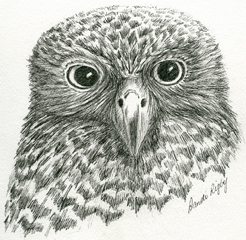
Why they need our help
Human actions are causing a decline in numbers through development on bushland fringes, removal of trees and vegetation and road deaths
They are a threatened species — there may be as few as 5000 in the world
Their habitat supports amazing wildlife, enriches our lives and connects us with nature
Future generations deserve to see these birds in the wild
How you can help
Download a flier and give it to your friends and neighbours to read
Download our position paper paper which is designed to educate and encourage all levels of government, professionals, groups, communities and individuals to protect and increase the number of Powerful Owls in urban areas
Make your garden Powerful Owl friendly
Submit sightings to This email address is being protected from spambots. You need JavaScript enabled to view it. (give the time, date, place, any interesting details and, if possible, attach a photo or recording)
Contact your local council and politicians if you become aware of inappropriate development or clearing

This page is hosted by STEP on behalf of the Powerful Owl Coalition
How to make your garden Powerful Owl friendly
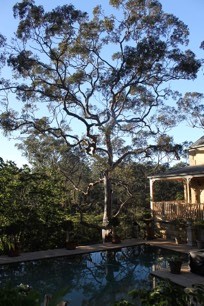
Protecting Powerful Owls
How to make your garden owl friendly
Maintain and protect your old trees and value your trees hollows — they’re homes for frogs, possums, sugar gliders and birds
Install a nest box
Plant native trees and shrubs
Plant understorey trees and shrubs to support prey species
Plant shrubs in dense, continuous groupings for birds
Don’t plant climbers and plants close to trees as they can damage the bark
Keep thick mulch away from with tree trunks
Avoid changing soil levels under tree canopies to maintain healthy tree roots
Employ reputable arborists to prune trees (you may need council permission)
Plant a gum tree, but not too close to your house, for future generations of Powerful Owls – you will also enjoy its beauty, wildlife and shade
Protect Ringtail Possum dreys (they look like footballs made of twigs)
Reduce hard surfaces such as paving
Let’s enhance our lives too
Residential areas with mature trees and canopies are more desirable and therefore valuable, than those without
By planting and caring for your trees and shrubs you will:
- reduce the temperature of your home thus saving money on cooling
- beautify your home
- improve your streetscape
- increase the amenity of your local area
and all the while you will be protecting Powerful Owls! What’s not to like?

This page is hosted by STEP on behalf of the Powerful Owl Coalition
What do Powerful Owls need to survive?
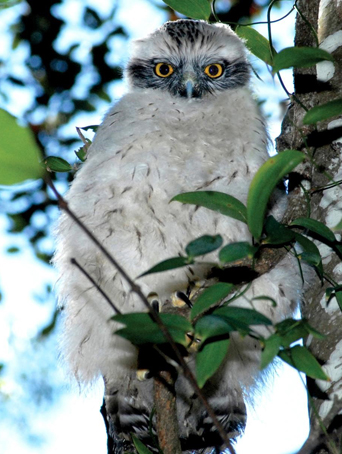
Protecting Powerful Owls
What do they need to survive?
Huge old growth trees more than 80 cm in diameter, with hollow entrances of 40 cm or more
Roosting trees with dense canopies, particularly near rivers, creeks and gullies
Foraging areas of complex vegetation large enough to support abundant prey species such as possums and birds
Urban green spaces, bushland and leafy gardens
Safe flight paths through bushland and urban areas
Humans to help them survive and thrive

This page is hosted by STEP on behalf of the Powerful Owl Coalition
Do you know that Powerful Owls
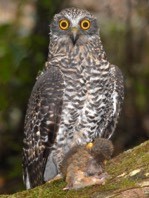
Protecting Powerful Owls
Do you know that they ...
Are Australia’s largest owl
Are an icon of the Australian night
Are charismatic, impressive birds
Top predators which help to keep our ecosystems in balance, e.g. by controlling possum populations
Are only found along Australia’s east coast
Live for up to 25 years in the wild
Have long and strong partner bonds
Grow up to 60 cm in height
Have a wingspan of up to 140 cm
Have striking yellow eyes
 Have large orange feet with strong, sharp talons
Have large orange feet with strong, sharp talons
Are brown and white with brown chevrons on a white chest
Chicks have downy white chests and grey masks
Nest in large hollows of trees over 150 years old
Have a delightful low ‘hoot hoot’
Need to eat approximately one possum (or flying fox) per night

This page is hosted by STEP on behalf of the Powerful Owl Coalition

